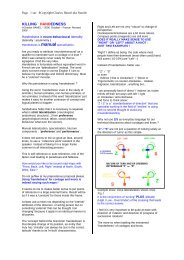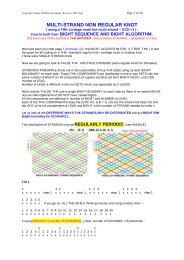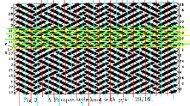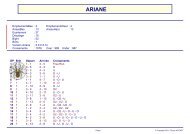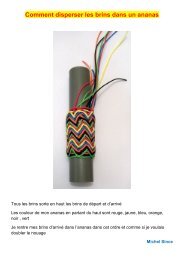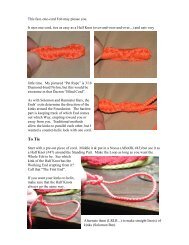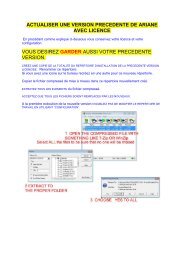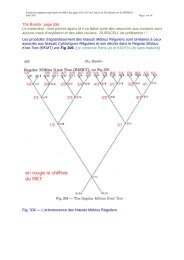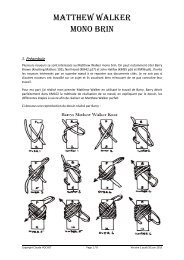MULTISTRAND-knots-ba.. - Charles HAMEL - Free
MULTISTRAND-knots-ba.. - Charles HAMEL - Free
MULTISTRAND-knots-ba.. - Charles HAMEL - Free
Create successful ePaper yourself
Turn your PDF publications into a flip-book with our unique Google optimized e-Paper software.
Copyright <strong>Charles</strong> <strong>HAMEL</strong> aka Nautile 2009 March Page 1 on 20<br />
MULTI-STRAND NON REGULAR KNOT<br />
( using a THK cordage route but multi-strand ) :<br />
how to built their BIGHT SEQUENCE AND BIGHT ALGORITHM.<br />
(the hard core of the method is THE BRAIDER ; that is mainly SCHAAKE – adaptation is mine)<br />
We have seen (my web page Turkshead_12) the BIGHT ALGORITHM FOR A ‘TRUE’ THK ( in fact<br />
this goes for all coding on a THK –standard regular knot– cordage route (shadow).<br />
Those were SINGLE STRAND <strong>knots</strong><br />
Now we are going to look at FALSE THK : MULTIPLE STRANDS (semi-regular <strong>knots</strong> for Schaake).<br />
STANDARD PINEAPPLE <strong>knots</strong> are in fact assemblies of true THK albeit using several ‘BIGHT<br />
BOUNDARY’ on each side. Those THK COMPONENTS are distributed in one or two SETS with the<br />
same number of BIGHT (that will form BIGHT-NEST), and ODD number of LEAD.<br />
Number of LEAD is different in the two SETS which are separated by 2 LEADS.<br />
Multi-strands ‘FALSE’ THK use a single BIGHT BOUDARY on each side so there is no nested BIGHT.<br />
All the components are identical in number of BIGHT and NUMBER of LEAD.<br />
Each of the THK COMPONENTS obey the (GDC of L & B = 1) rule but the whole knot does not and<br />
the GDC of its full complement of LEAD and BIGHT is the number of STRAND needed to make it.<br />
Let us look at the DIFFERENT WAYS THE STRANDS MAY BE DISTRIBUTED along the BIGHT RIM<br />
(bight boundary for SCHAAKE ).<br />
This distribution of STRANDS may be REGULARLY PERIODIC (see ANNEXE)<br />
FIG 1<br />
1 1 2 1 2 3 1 2 3 4<br />
x x x x x step 1 x x x x x step 1 x x x x x step 1 x x x x x step 1<br />
1 2 3 4 5<br />
x x x x x<br />
if you go on, ALL THE WHILE thinking circular and using modulo, then →<br />
1 2 3 4 5 6 7 8 9 10 11 12 13 14 15 16 17 18 19 20<br />
x x x x x x x x x x x x x x x x x x x x<br />
when using [MODULO ( number of STRANDS)] ,( here number of STRANDS ==5) becomes :<br />
0 0 0 0<br />
1 2 3 4 5 1 2 3 4 5 1 2 3 4 5 1 2 3 4 5<br />
x x x x x x x x x x x x x x x x x x x x
Copyright <strong>Charles</strong> <strong>HAMEL</strong> aka Nautile 2009 March Page 2 on 20<br />
The right side diagram in FIG 1 : 1 3 5 2 4 despite what you may intuitively believe HAS a<br />
REGULAR PERIOD.<br />
1 + step 2 = 3 3 + step 2 = 5…….<br />
1 step 2 (one bight-step) 3 step 2 5 step 2 7 step 2 9<br />
Do you get the regular periodicity now you knot it exists <br />
No !<br />
Then you are forgetting to think circular / modular ; just apply [MODULO Number of STRAND] (5 in<br />
this case) and you get :<br />
1 step 2 3 step 2 5 step 2 2 step 2 4<br />
So only ONE BIGHT SEQUENCE leading to only ONE BIGHT ALGORITHM that will be applied<br />
successively, periodically to each STRAND are necessary.<br />
BUT it can also be NOT REGULARLY PERIODIC :<br />
1 5 3 2 4 whatever you do is NOT periodic<br />
Just try :<br />
1 step 4 (one bight step) 5 step 3 (one bight<br />
step) 3 step 4 (one bight step) 2<br />
2 step 2 (one bight step) 4<br />
Still it is easy to realise that there may exist<br />
SUB-periods and go searching for them :<br />
1 step 1 2 one sub-period : there are 2 BIGHT<br />
between BIGHT 1 and BIGHT 2 making 3 bight<br />
steps.<br />
FIG 2<br />
no sub-period Are YOU SURE OF THAT <br />
May be circular / modular was plainly forgotten <br />
5 NO bight in-between and step minus 2 3 ONE<br />
BIGHT in-between and step +1 4<br />
imagine 5 3 4 distributed clockwise on the perimeter of a circle (just as they are in fact on the<br />
circular BIGHT BOUNDARY) then you will be able to «commence the running of the round track »<br />
anywhere you want.<br />
Start at 3 then you can read 3 4 5 so one sub-period with step 1 does exist (2 bight steps) .<br />
That is the moment a bright brain will : “OH NO ! that does not work ! look :<br />
OK between 3 and 4 there is one BIGHT ( Bight number 2 ) but between 4 and 5 there are 11<br />
BIGHTS “<br />
Yes indeed.<br />
So what <br />
I insist it is step 1 ( 2 bight-steps)<br />
Once again the MODULO (here 5)was lost from sight.<br />
Looking at it like that : 1 5 3 2 4 x x x x x x x x x x x 5 you will believe interjection is right.<br />
Yet it is wrong !<br />
You have to look at it so :<br />
1 2 3 4 5 6 7 8 9 10 11 12 13 14 15 1 2 BIGHTS going round and round…<br />
1 5 3 2 4 x x x x x x x x x x 1 5 the two highlighted 5 5 are the same 5 just as 1 1 are<br />
the same 1 (circularity == perimeter , the « closing of the path” = circuit , the ‘re-entering’ of the<br />
sequence)
Copyright <strong>Charles</strong> <strong>HAMEL</strong> aka Nautile 2009 March Page 3 on 20<br />
1 5 3 2 4 1 5 3 2 4 1 5 3 2 4 1 5 the step between each component of 3 4 5 is indeed step 1 (2<br />
‘bight-steps’)<br />
2 bight steps, there is 1 BIGHT between any two of them considered as « ORDINAL », in their<br />
numerical ORDER or RANK : 3, 4 , 5 . So 3 4 5 is another sub-period.<br />
We now have 2 sub-periods sequences<br />
1 2 and 3 4 5 ……. so we need to built 2 ‘BIGHT SEQUENCE’ and 2 ‘BIGHT ALGORITHM’<br />
BUILDING THE BIGHT SEQUENCE.<br />
Knots in FIG 1 are<br />
20 LEAD 15 BIGHT 5 STRAND<br />
GDC of 20 (number of LEADS) and 15 (number of BIGHTS) is 5<br />
20 = 2 * 2 * 5 (factoring with prime factors)<br />
15 = 3 * 5<br />
FIVE SINGLE STRAND COMPONENTS THAT WILL BE EACH 4 LEAD 3 BIGHT<br />
To get the BIGHT SEQUENCE we need to provide for each BIGHT hence : ‘B’ signs ‘@’ IN LINE<br />
(may be we would have done better putting them in a circle : chariots defence style ! )<br />
xxxxxxxxxxxxxxxxxxxxxxxxxxxxxxxxxxxxxxxxxxxxxxxxxxxxxxxxxxxxxxxxxxxxxxxxxxxxxxxxxxxxxxxxxxxxxxxxxxxxxxxxxxxxxxxxxxxxx<br />
1 2 3 B-3 B-2 B-1 B<br />
@ @ @ @ @ @ @ @ @ @ @ @ @ @ @<br />
xxxxxxxxxxxxxxxxxxxxxxxxxxxxxxxxxxxxxxxxxxxxxxxxxxxxxxxxxxxxxxxxxxxxxxxxxxxxxxxxxxxxxxxxxxxxxxxxxxxxxxxxxxxxxxxxxxxxx<br />
That would be OK as it is, for a single strand knot that is, but there are FIVE different STRANDS in this<br />
case. We better keep that in mind. Each single strand making on each bight rim (B / GDC) or<br />
(B / Number of Strand (NS) ) == 15/5 = 3 BIGHT PERIODICALLY DISPOSED :<br />
It is now time for an important note and another bout of my expounding on the absolute necessity of<br />
never confusing logical planes under penalty of being lost and some times even plain stupid.<br />
Here two logical planes are at play : SPACE & TIME.<br />
FIG 1 and FIG 2 are showing the SPACE distribution of the components <strong>knots</strong> and theirs BIGHTS.<br />
The illustration here under, or BIGHT SEQUENCE, show the TIME distribution of the STRANDS and<br />
BIGHTS. If you confuse one representation with the other you will be lost in deep dark woods !<br />
@ @ @ @ @ @ @ @ @ @ @ @ @ @ @<br />
Lets us do the 20L 15B periodic repartition that is in the left side diagram of FIG 1<br />
First find the « step » : it is still (-L) modulo B so (-20 ) mod 15 = 10<br />
The writing of the first STRAND @ will be<br />
xxxxxxxxxxxxxxxxxxxxxxxxxxxxxxxxxxxxxxxxxxxxxxxxxxxxxxxxxxxxxxxxxxxxxxxxxxxxxxxxxxxxxxxxxxxxxxxxxxxxxxx<br />
0<br />
@ @ @ @ @ @ @ @ @ @ @ @ @ @ @<br />
1 2 3 4 5 6 7 8 9 10<br />
xxxxxxxxxxxxxxxxxxxxxxxxxxxxxxxxxxxxxxxxxxxxxxxxxxxxxxxxxxxxxxxxxxxxxxxxxxxxxxxxxxxxxxxxxxxxxxxxxxxxxxx<br />
0 1<br />
@ @ @ @ @ @ @ @ @ @ @ @ @ @ @<br />
5 6 7 8 9 10 1 2 3 4<br />
xxxxxxxxxxxxxxxxxxxxxxxxxxxxxxxxxxxxxxxxxxxxxxxxxxxxxxxxxxxxxxxxxxxxxxxxxxxxxxxxxxxxxxxxxxxxxxxxxxxxxxx<br />
0 2 1<br />
@ @ @ @ @ @ @ @ @ @ @ @ @ @ @<br />
xxxxxxxxxxxxxxxxxxxxxxxxxxxxxxxxxxxxxxxxxxxxxxxxxxxxxxxxxxxxxxxxxxxxxxxxxxxxxxxxxxxxxxxxxxxxxxxxxxxxxxx<br />
Now we need to distinguish between the different STRANDS, so the first one having « used » the<br />
DIGITS we have now to go « LETTERS » :<br />
second STRAND is denoted A , third STRAND is B, fourth STRAND is C and so on…<br />
How can we now dispose the BIGHT SEQUENCE THAT THE SECOND STRAND ‘A’ MAKES <br />
Err…… Well….err……
Copyright <strong>Charles</strong> <strong>HAMEL</strong> aka Nautile 2009 March Page 4 on 20<br />
Here is what is written in THE BRAIDER Volume I Issue N° 8 PAGE 174<br />
[open quote]<br />
…/ first we lay down string #1 ; for this string the above complementary cyclic night-number scheme<br />
applies. Then we lay down string #2, but since string #1 already occupies the bight-points immediately<br />
below those which string #2 is going to occupy, we mark the bight-points immediately to the left ( in<br />
cyclic fashion of course ) of those who possess numerical value with A. Hence for string #2 we obtain<br />
the complementary cyclic scheme !<br />
0 A 2 A 1 A<br />
° ° ° ° ° ° ° ° ° ° ° ° ° ° °<br />
Now we lay string#3, but since strings #1 and #2 already occupy the two consecutive bight points<br />
immediately below those which string #3 is going to occupy, we mark the bight-points immediately to<br />
the left ( in cyclic fashion of course ) of those who possess the letter A with B. Hence for string #3 we<br />
obtain the complementary cyclic bight-number scheme :<br />
0 B A 2 B A 1 B A<br />
° ° ° ° ° ° ° ° ° ° ° ° ° ° °<br />
/…<br />
[end quote]<br />
As I don’t think that everyone will get the above first time around here is now my own explanation.<br />
0 2 1<br />
@ @ @ @ @ @ @ @ @ @ @ @ @ @ @<br />
In fact you should not accept to see there a STRAIGHT LINE but chose to see a CURVED LINE<br />
MAKING A FULL CIRCLE :<br />
Imagine you take the « <strong>ba</strong>r » of @ with one hand on each extremity then you bend it downward on<br />
your knee, making a circle (mind experience only !) like the bights rim does.<br />
Keep that in mind each time you find difficulty in understanding the explanations.<br />
Consider a running track :<br />
first ‘runner’ ( strand ) to start will have yellow O<br />
line as starting line, then will run for (-L)modulo B,<br />
that will be till mark 1, then will run again for<br />
(-L)modulo B ( mark 2 ), then will run again for<br />
(-L)modulo B which bring it <strong>ba</strong>ck at 0 ; the start line<br />
is also its arrival line ‘closing the circuit’.<br />
What cannot be seen on the straight linear<br />
representation is that the second runner (strand) is<br />
starting after in time so is behind ( relative to the<br />
direction of running ) in space to represent it<br />
being ‘behind’ in time.<br />
The segmented run made by STRAND #2 or A will be exactly identical in segment length, (-L)modulo<br />
B, and be marked by A.<br />
Then the third runner (strand B) will be placed on the running track just behind the last runner A : that<br />
will be B fictive start line …..<br />
It happen that the “behind” is worth in this case ONE Bight position, in some other cases it will be<br />
worth, TWO, or THREE, or NS – 1 ( Number of Strand less one ).<br />
I feel that it is easier to grasp Later = Behind than Below / Left but it is essentially identical.<br />
You may also chose to look at the situation as in the following illustration
Copyright <strong>Charles</strong> <strong>HAMEL</strong> aka Nautile 2009 March Page 5 on 20<br />
The writing goes on like that :<br />
--------------------------------------------------------------------------------------------<br />
0 A 2 A 1 A<br />
@ @ @ @ @ @ @ @ @ @ @ @ @ @ @<br />
--------------------------------------------------------------------------------------------<br />
0 B A 2 B A 1 B A<br />
@ @ @ @ @ @ @ @ @ @ @ @ @ @ @<br />
--------------------------------------------------------------------------------------------<br />
0 C B A 2 C B A 1 C B A<br />
@ @ @ @ @ @ @ @ @ @ @ @ @ @ @<br />
--------------------------------------------------------------------------------------------<br />
0 D C B A 2 D C B A 1 D C B A<br />
@ @ @ @ @ @ @ @ @ @ @ @ @ @ @<br />
--------------------------------------------------------------------------------------------<br />
We now have the Complementary Bight Sequence.<br />
We have 20 L so we need to provide for each of them by writing (L + 1) signs ( here signs are # )<br />
xxxxxxxxxxxxxxxxxxxxxxxxxxxxxxxxxxxxxxxxxxxxxxxxxxxxxxxxxxxxxxxxxxxxxxxxxxxxxxxxxxxxxxxxxxxxxxxxxxxxxxxxxxxxxxxxxxxxxxxxxxxxxxxxxx<br />
1 2 3 4 L-2 L-1 L L+1<br />
# # # # # # # # # # # # # # # # # # # # #<br />
xxxxxxxxxxxxxxxxxxxxxxxxxxxxxxxxxxxxxxxxxxxxxxxxxxxxxxxxxxxxxxxxxxxxxxxxxxxxxxxxxxxxxxxxxxxxxxxxxxxxxxxxxxxxxxxxxxxxxxxxxxxxxxxxxx<br />
You will remember from the standard THK study that we need to ‘differentiate’ the BIGHT RIM (border,<br />
boundary…. ) with for example : # left BIGHT RIM # right BIGHT RIM<br />
xxxxxxxxxxxxxxxxxxxxxxxxxxxxxxxxxxxxxxxxxxxxxxxxxxxxxxxxxxxxxxxxxxxxxxxxxxxxxxxxxxxxxxxxxxxxxxxxxxxxxxxxxxxxxxxxxxxxxxxxxxxxxxxxxx<br />
# # # # # # # # # # # # # # # # # # # # #<br />
xxxxxxxxxxxxxxxxxxxxxxxxxxxxxxxxxxxxxxxxxxxxxxxxxxxxxxxxxxxxxxxxxxxxxxxxxxxxxxxxxxxxxxxxxxxxxxxxxxxxxxxxxxxxxxxxxxxxxxxxxxxxxxxxxx<br />
the (L – 2) # signs stand for the “column” where the crossings happen in this COLUMN-CODED knot.<br />
We have the complementary<br />
0 D C B A 2 D C B A 1 D C B A<br />
we get the cyclic just by “reversing “ the complementary<br />
A B C D 1 A B C D 2 A B C D 0<br />
then we write the BIGHT ALGORITHM<br />
xxxxxxxxxxxxxxxxxxxxxxxxxxxxxxxxxxxxxxxxxxxxxxxxxxxxxxxxxxxxxxxxxxxxxxxxxxxxxxxxxxxxxxxxxxxxxxxxxxxxxxxxxxxxxxxxxxxxxxxxxxxxxxxxxx<br />
0 D C B A 2 D C B A 1 D C B A<br />
# # # # # # # # # # # # # # # # # # # # #<br />
A B C D 1 A B C D 2 A B C D 0<br />
xxxxxxxxxxxxxxxxxxxxxxxxxxxxxxxxxxxxxxxxxxxxxxxxxxxxxxxxxxxxxxxxxxxxxxxxxxxxxxxxxxxxxxxxxxxxxxxxxxxxxxxxxxxxxxxxxxxxxxxxxxxxxxxxxx<br />
ALL columns are NOT covered so we just go CIRCULAR / PERIODIC / CYCLIC
Copyright <strong>Charles</strong> <strong>HAMEL</strong> aka Nautile 2009 March Page 6 on 20<br />
xxxxxxxxxxxxxxxxxxxxxxxxxxxxxxxxxxxxxxxxxxxxxxxxxxxxxxxxxxxxxxxxxxxxxxxxxxxxxxxxxxxxxxxxxxxxxxxxxxxxxxxxxxxxxxxxxxxxxxxxxxxxxxxxxxxxx<br />
0 D C B A 2 D C B A 1 D C B A 0 D C B A Ф<br />
# # # # # # # # # # # # # # # # # # # # #<br />
Ф A B C D 0 A B C D 1 A B C D 2 A B C D 0<br />
xxxxxxxxxxxxxxxxxxxxxxxxxxxxxxxxxxxxxxxxxxxxxxxxxxxxxxxxxxxxxxxxxxxxxxxxxxxxxxxxxxxxxxxxxxxxxxxxxxxxxxxxxxxxxxxxxxxxxxxxxxxxxxxxxxxxx<br />
Note that there is an empty slot Ф above the RIGHT side bight rim and under the LEFT side bight rim.<br />
The reason is quite evident : there is no crossing on a BIGHT RIM.<br />
There is a special way to read all that : Remember <br />
-----------------------------------------------------------------------------------------------------------------------<br />
CONCERN THE ODD NUMBERED HALF-PERIOD<br />
TO BE READ FROM LEFT TO RIGHT<br />
0 D C B A 2 D C B A 1 D C B A 0 D C B A<br />
# # # # # # # # # # # # # # # # # # # # #<br />
A B C D 0 A B C D 1 A B C D 2 A B C D 0<br />
TO BE READ FROM RIGHT TO LEFT<br />
CONCERN THE EVEN NUMBERED HALF-PERIOD<br />
-----------------------------------------------------------------------------------------------------------------------<br />
Add now the appropriate code signs in place of the # signs as in the following example :<br />
--------------------------------------------------------------------------------------------------------------------------<br />
CONCERN THE ODD NUMBERED HALF-PERIODS going low left to up right (mandrel)<br />
TO BE READ FROM LEFT TO RIGHT<br />
0 D C B A 2 D C B A 1 D C B A 0 D C B A<br />
# / / / \ / / \ \ / / \ \ / / \ \ / / / #<br />
A B C D 0 A B C D 1 A B C D 2 A B C D 0<br />
TO BE READ FROM RIGHT TO LEFT<br />
CONCERN THE EVEN NUMBERED HALF-PERIODS going low right to up left (mandrel)<br />
--------------------------------------------------------------------------------------------------------------------------<br />
/ is seen by an ODD numbered HP running from low left to up right this is an OVER<br />
/ is seen by an EVEN numbered HP running from low right to up left this is an UNDER<br />
\ is seen by an ODD numbered HP running from low left to up right this is an UNDER<br />
\ is seen by an EVEN numbered HP running from low right to up left this is an OVER<br />
so we could also chose to write :<br />
--------------------------------------------------------------------------------------------------------------------------<br />
CONCERN THE ODD NUMBERED HALF-PERIODS going low left to up right (mandrel)<br />
TO BE READ FROM LEFT TO RIGHT<br />
0 D C B A 2 D C B A 1 D C B A 0 D C B A ()<br />
O O O U U O O U U O O U U O O U O O O<br />
# / / / \ \ / / \ \ / / \ \ / / \ / / / #<br />
U U U O U U O O U U O O U U U O U U U<br />
() A B C D 0 A B C D 1 A B C D 2 A B C D 0<br />
TO BE READ FROM RIGHT TO LEFT<br />
CONCERN THE EVEN NUMBERED HALF-PERIODS going low right to up left (mandrel)<br />
--------------------------------------------------------------------------------------------------------------------------<br />
which can even be written as ( that is what I prefer and what I do, as it is IMO quite superior to the /<br />
and \ in ease of use and lower mistake-rate : H(igh) is Over L(ow) is Under just because H and L are<br />
less prone to mistakes than u and o or U and O )
Copyright <strong>Charles</strong> <strong>HAMEL</strong> aka Nautile 2009 March Page 7 on 20<br />
--------------------------------------------------------------------------------------------------------------------------<br />
CONCERN THE ODD NUMBERED HALF-PERIODS going low left to up right (mandrel)<br />
TO BE READ FROM LEFT TO RIGHT<br />
0 D C B A 2 D C B A 1 D C B A 0 D C B A ()<br />
H H H L L H H L L H H L L H H L H H H<br />
# xxxxxxxxxxxxxxxxxxxxxxxxxxxxxxxxxxxxxxxxxxxxxxxxxxxxxxxxxxxxxxxxxxxxxxxxxxxxxxxxxxxxxxxxxxx #<br />
L L L H H L L H H L L H H L L H L L L<br />
() A B C D 0 A B C D 1 A B C D 2 A B C D 0<br />
TO BE READ FROM RIGHxT TO LEFT<br />
CONCERN THE EVEN NUMBERED HALF-PERIODS going low right to up left (mandrel)<br />
--------------------------------------------------------------------------------------------------------------------------<br />
It “just happened so” that the line of code # / / \ ….. \ / / #<br />
is COMMON to EVEN and ODD HP but it may happen that you need one line of code for each<br />
sort of even / odd HP.<br />
The making of different algorithms is needed for COLUMN CODED <strong>knots</strong> that have their STRANDS in<br />
a NON REGULARLY PERIODIC disposition or for NEITHER COLUMN-CODED NOR ROW-CODED<br />
<strong>knots</strong>.<br />
ALWAYS DISTINGUISH BETWEEN LOGICAL PLANES :<br />
Here the one of THE CORDAGE ROUTE<br />
and the one of the CODING that is just ‘put on’ the cordage route.<br />
With the same cordage route may come several different coding<br />
Examples taken from THE BRAIDER Volume I issue N° 9<br />
On a 25 L 15 B cordage route you may have (a few of the possible !)<br />
[open quote]<br />
/ / \ \ / / \ \ / / \ \ / / \ \ / / \ \ / / \ \ …. or …. / / / \ \ \ / / / \ \ \ / / / \ \ \ / / / \ \ \… or… / / / / \ \ \ \ / / / / \ \ \ \<br />
/ / / / \ \ \ \….or….. / / \ \ \ \ / / / / \ \ \ \ / / / / \ \ \ \ / / /<br />
[end quote]<br />
Now, just to be more knowledgeable thanks to SCHAAKE and THE BRAIDER pioneering work<br />
allowing us to be “dwarves on the giant’s shoulder “ we will see the cases of<br />
- non regularly periodic column-coded semi-regular knot<br />
- neither column-coded nor row-coded semi-regular knot<br />
PLEASE ATTACH YOUR SEAT BELT AND EXTINGUISH CIGARETTE<br />
AND TURN OFF ANY PORTABLE THEY BE PHONE OR PC ….;-)<br />
THE CASE OF THE NON REGULARLY PERIODIC COLUMN-CODED<br />
Lets us go <strong>ba</strong>ck to FIG 2<br />
You will remember that we found that there were TWO<br />
sub-periods 1 2 and 3 4 5 hence 2 ‘Bight Sequence’<br />
and 2 ‘Bight Algorithm’ to make<br />
One COMMON to STRAND #1 and STRAND #2<br />
The other one, different from the first is COMMON to<br />
STRANDS #3 , #4 and #5<br />
20L 15 B it imply ( GDC = 5 )<br />
(-L)modulo B == (-20)modulo 15 = 10
Copyright <strong>Charles</strong> <strong>HAMEL</strong> aka Nautile 2009 March Page 8 on 20<br />
****************FOR STRAND # 1 and STRAND # 2************************************************<br />
xxxxxxxxxxxxxxxxxxxxxxxxxxxxxxxxxxxxxxxxxxxxxxxxxxxxxxxxxxxxxxxxxxxxxxxxxxxxxxx<br />
@ @ @ @ @ @ @ @ @ @ @ @ @ @ @<br />
xxxxxxxxxxxxxxxxxxxxxxxxxxxxxxxxxxxxxxxxxxxxxxxxxxxxxxxxxxxxxxxxxxxxxxxxxxxxxxx<br />
Note that now the “lateness” of A on DIGIT is not equal to ONE but to THREE BIGHTS<br />
xxxxxxxxxxxxxxxxxxxxxxxxxxxxxxxxxxxxxxxxxxxxxxxxxxxxxxxxxxxxxxxxxxxxxxxxxxxxxxxxxxxxxxxxxxxxxx<br />
@ @ @ @ @ @ @ @ @ @ @ @ @ @ @<br />
1 2 3 4 5 6 7 8 9 10<br />
xxxxxxxxxxxxxxxxxxxxxxxxxxxxxxxxxxxxxxxxxxxxxxxxxxxxxxxxxxxxxxxxxxxxxxxxxxxxxxxxxxxxxxxxxxxxxx<br />
0 2 1<br />
@ @ @ @ @ @ @ @ @ @ @ @ @ @ @<br />
5 6 7 8 9 10 1 2 3 4<br />
xxxxxxxxxxxxxxxxxxxxxxxxxxxxxxxxxxxxxxxxxxxxxxxxxxxxxxxxxxxxxxxxxxxxxxxxxxxxxxxxxxxxxxxxxxxxxx<br />
0 2 A 1<br />
@ @ @ @ @ @ @ @ @ @ @ @ @ @ @<br />
-3 - 2-3 -2 -1<br />
8 9 10 1 2 3 4 5 6 7<br />
xxxxxxxxxxxxxxxxxxxxxxxxxxxxxxxxxxxxxxxxxxxxxxxxxxxxxxxxxxxxxxxxxxxxxxxxxxxxxxxxxxxxxxxxxxxxxx<br />
0 A 2 A 1<br />
@ @ @ @ @ @ @ @ @ @ @ @ @ @ @<br />
-3 - 2-3 -2 -1<br />
8 9 10 1 2 3 4 5 6 7<br />
xxxxxxxxxxxxxxxxxxxxxxxxxxxxxxxxxxxxxxxxxxxxxxxxxxxxxxxxxxxxxxxxxxxxxxxxxxxxxxxxxxxxxxxxxxxxxx<br />
0 A 2 A 1 A<br />
@ @ @ @ @ @ @ @ @ @ @ @ @ @ @<br />
-3 - 2-3 -2 -1<br />
1 1 2 3 4 5 6 7 8 9 10<br />
xxxxxxxxxxxxxxxxxxxxxxxxxxxxxxxxxxxxxxxxxxxxxxxxxxxxxxxxxxxxxxxxxxxxxxxxxxxxxxxxxxxxxxxxxxxxxx<br />
We now have the complementary bight sequence for STRANDS #1 and #2<br />
It is easy to get the BIGHT ALGORITHM now<br />
- -<br />
0 A 2 A 1 A<br />
# # # # # # # # # # # # # # # # # # # # #<br />
- -<br />
0 A 2 A 1 A 0 A<br />
# # # # # # # # # # # # # # # # # # # # #<br />
- -<br />
0 A 2 A 1 A 0 A<br />
# # # # # # # # # # # # # # # # # # # # #<br />
A 0 A 1 A 2 A 0<br />
- -<br />
---------------------------------------------------------------------------------------------------------------------------------<br />
For ODD numbered HP read left to right<br />
0 A 2 A 1 A 0 A<br />
# # # # # # # # # # # # # # # # # # # # #<br />
A 0 A 1 A 2 A 0<br />
For EVEN numbered HP read right to left<br />
--------------------------------------------------------------------------------------------------------------------------------<br />
Just replace the # signs by CODE signs and work out the code for each Half-Period for STRAND #1<br />
and STRAND #2
Copyright <strong>Charles</strong> <strong>HAMEL</strong> aka Nautile 2009 March Page 9 on 20<br />
****************FOR STRAND # 3, STRAND # 4 and STRAND # 5***************************************<br />
xxxxxxxxxxxxxxxxxxxxxxxxxxxxxxxxxxxxxxxxxxxxxxxxxxxxxxxxxxxxxxxxxxxxxxxxxxxxxxx<br />
@ @ @ @ @ @ @ @ @ @ @ @ @ @ @<br />
xxxxxxxxxxxxxxxxxxxxxxxxxxxxxxxxxxxxxxxxxxxxxxxxxxxxxxxxxxxxxxxxxxxxxxxxxxxxxxx<br />
Note that<br />
the “lateness” of A on 0 is not equal to ONE but to FOUR BIGHT<br />
the “lateness” of B on 0 that was equal to TWO is still ( happenstance ) of TWO BIGHT<br />
the “lateness” of C on 0 is not equal to THREE but to ONE<br />
the “lateness” of D on 0 is not equal to FOUR but to THREE BIGHT<br />
so you get the complementary Bight sequence for STRAND #3, #4 and #5<br />
xxxxxxxxxxxxxxxxxxxxxxxxxxxxxxxxxxxxxxxxxxxxxxxxxxxxxxxxxxxxxxxxxxxxxxxxxxxxxxxxxxxxxxxxxxxxxxxxxxxxxxxxxxxxxxxxxxxxxxxxxx<br />
0 A D B C 2 A D B C 1 A D B C<br />
-4 -3 -2 -1 @ @ @ @ @ @ @ @ @ @ @ @ @ @ @<br />
A D B C ( waiting behind the scene in “starting order” )<br />
xxxxxxxxxxxxxxxxxxxxxxxxxxxxxxxxxxxxxxxxxxxxxxxxxxxxxxxxxxxxxxxxxxxxxxxxxxxxxxxxxxxxxxxxxxxxxxxxxxxxxxxxxxxxxxxxxxxxxxxxxx<br />
I leave you working the rest by yourself as you had more than enough explanation to do it alone.<br />
Look in the help note or the annexe if necessary<br />
THE CASE OF THE NEITHER COLUMN-CODED NOR ROW-CODED<br />
It is NOT that there is no REGULARITY in<br />
the PERIODICITY 1 2 3 but the point is<br />
that<br />
THE CODING IS DIFFERENT<br />
FOR EACH ONE OF<br />
THE THREE STRANDS<br />
this IMPLY :<br />
THREE ‘BIGHT SEQUENCE’<br />
AND<br />
THREE ‘BIGHT ALGORITHM’<br />
ONE FOR EACH STRAND<br />
MORE ! FOR TWO STRANDS THE<br />
CODING IS DIFFERENT FOR THE EVEN<br />
NUMBERED HALF-PERIOD AND THE<br />
ODD-NUMBERED HALF-PERIOD OF<br />
THE SAME STRAND.<br />
This ask for “adaptation and intelligence” (useful traits) so let us leave hand skill aside and chose brain<br />
skill instead.<br />
(-L)modulo B == (-21) modulo 15 = 9 B / GDC = NS (number of BIGHT for each of the 3<br />
components)<br />
There is 5 BIGHT STEPS from strand #1 to strand #2 ( letter A )and 10 BIGHT STEPS from strand<br />
#1 to strand #3 (letter B ) but 5 modulo NS is 2 and 10 modulo NS is 1<br />
So A lag 2 places behind and B lag 1 place behind, so for each STRAND it will be for 15 BIGHTS :<br />
xxxxxxxxxxxxxxxxxxxxxxxxxxxxxxxxxxxxxxxxxxxxxxxxxxxxxxxxxxxxxxxxxxxxxxxxxxxxxxxxxxxxxxxxxxxxxxxxxxxxxxxxxxxxxxxxxxxxxxxxxxxxxxxxxxxxxxxxxxxxxxxxxx<br />
@ @ @ @ @ @ @ @ @ @ @ @ @ @ @<br />
xxxxxxxxxxxxxxxxxxxxxxxxxxxxxxxxxxxxxxxxxxxxxxxxxxxxxxxxxxxxxxxxxxxxxxxxxxxxxxxxxxxxxxxxxxxxxxxxxxxxxxxxxxxxxxxxxxxxxxxxxxxxxxxxxxxxxxxxxxxxxxxxxx
Copyright <strong>Charles</strong> <strong>HAMEL</strong> aka Nautile 2009 March Page 10 on 20<br />
STRAND # 1<br />
xxxxxxxxxxxxxxxxxxxxxxxxxxxxxxxxxxxxxxxxxxxxxxxxxxxxxxxxxxxxxxxxxxxxxxxxxxxxxxxxxxxxxxxxxxxxxxxxxxxxxxxxxxxxxxxxxxxxxxxxxxxxxxxxxxxxxxxxxxxxxxxxxx<br />
0 1<br />
@ @ @ @ @ @ @ @ @ @ @ @ @ @ @<br />
1 2 3 4 5 6 7 8 9<br />
xxxxxxxxxxxxxxxxxxxxxxxxxxxxxxxxxxxxxxxxxxxxxxxxxxxxxxxxxxxxxxxxxxxxxxxxxxxxxxxxxxxxxxxxxxxxxxxxxxxxxxxxxxxxxxxxxxxxxxxxxxxxxxxxxxxxxxxxxxxxxxxxxx<br />
0 2 1<br />
@ @ @ @ @ @ @ @ @ @ @ @ @ @ @<br />
6 7 8 9 1 2 3 4 5<br />
xxxxxxxxxxxxxxxxxxxxxxxxxxxxxxxxxxxxxxxxxxxxxxxxxxxxxxxxxxxxxxxxxxxxxxxxxxxxxxxxxxxxxxxxxxxxxxxxxxxxxxxxxxxxxxxxxxxxxxxxxxxxxxxxxxxxxxxxxxxxxxxxxx<br />
finished it will be<br />
xxxxxxxxxxxxxxxxxxxxxxxxxxxxxxxxxxxxxxxxxxxxxxxxxxxxxxxxxxxxxxxxxxxxxxxxxxxxxxxxxxxxxxxxxxxxxxxxxxxxxxxxxxxxxxxxxxxxxxxxxxxxxxxxxxxxxxxxxxxxxxxxxx<br />
0 2 4 1 3<br />
@ @ @ @ @ @ @ @ @ @ @ @ @ @ @<br />
xxxxxxxxxxxxxxxxxxxxxxxxxxxxxxxxxxxxxxxxxxxxxxxxxxxxxxxxxxxxxxxxxxxxxxxxxxxxxxxxxxxxxxxxxxxxxxxxxxxxxxxxxxxxxxxxxxxxxxxxxxxxxxxxxxxxxxxxxxxxxxxxxx<br />
This COMPLEMENTARY BIGHT SEQUENCE WILL BE USED FOR 21L IN THE FOLLOWING<br />
BIGHT ALGORITHM<br />
xxxxxxxxxxxxxxxxxxxxxxxxxxxxxxxxxxxxxxxxxxxxxxxxxxxxxxxxxxxxxxxxxxxxxxxxxxxxxxxxxxxxxxxxxxxxxxxxxxxxxxxxxxxxxxxxxxxxxxxxxxxxxxxxxxxxxxxxxxxxxxxxxxxxxxx<br />
0 2 4 1 3 0 2<br />
# # # # # # # # # # # # # # # # # # # # # #<br />
xxxxxxxxxxxxxxxxxxxxxxxxxxxxxxxxxxxxxxxxxxxxxxxxxxxxxxxxxxxxxxxxxxxxxxxxxxxxxxxxxxxxxxxxxxxxxxxxxxxxxxxxxxxxxxxxxxxxxxxxxxxxxxxxxxxxxxxxxxxxxxxxxxxxxxx<br />
The PERIODIC ( CYCLIC for SCHAAKE ) is<br />
xxxxxxxxxxxxxxxxxxxxxxxxxxxxxxxxxxxxxxxxxxxxxxxxxxxxxxxxxxxxxxxxxxxxxxxxxxxxxxxxxxxxxxxxxxxxxxxxxxxxxxxxxxxxxxxxxxxxxxxxxxxxxxxxxxxxxxxxxxxxxxxxxxxxxxx<br />
# # # # # # # # # # # # # # # # # # # # # #<br />
2 0 3 1 4 2 0<br />
xxxxxxxxxxxxxxxxxxxxxxxxxxxxxxxxxxxxxxxxxxxxxxxxxxxxxxxxxxxxxxxxxxxxxxxxxxxxxxxxxxxxxxxxxxxxxxxxxxxxxxxxxxxxxxxxxxxxxxxxxxxxxxxxxxxxxxxxxxxxxxxxxxxxxxx<br />
which leads to<br />
xxxxxxxxxxxxxxxxxxxxxxxxxxxxxxxxxxxxxxxxxxxxxxxxxxxxxxxxxxxxxxxxxxxxxxxxxxxxxxxxxxxxxxxxxxxxxxxxxxxxxxxxxxxxxxxxxxxxxxxxxxxxxxxxxxxxxxxxxxxxxxxxxxxxxxx<br />
0 2 4 1 3 0 2<br />
# # # # # # # # # # # # # # # # # # # # # #<br />
2 0 3 1 4 2 0<br />
xxxxxxxxxxxxxxxxxxxxxxxxxxxxxxxxxxxxxxxxxxxxxxxxxxxxxxxxxxxxxxxxxxxxxxxxxxxxxxxxxxxxxxxxxxxxxxxxxxxxxxxxxxxxxxxxxxxxxxxxxxxxxxxxxxxxxxxxxxxxxxxxxxxxxxx<br />
Just ‘polish it’ to<br />
---------------------------------------------------------------------------------------------------------------------------<br />
Read left to right (ODD numbered HP )<br />
0 2 4 1 3 0 2<br />
# / / \ \ / / / \ \ \ / / / \ \ \ / / \ \ #<br />
2 0 3 1 4 2 0<br />
(EVEN numbered HP ) Read right to left<br />
--------------------------------------------------------------------------------------------------------------------------<br />
his
Copyright <strong>Charles</strong> <strong>HAMEL</strong> aka Nautile 2009 March Page 11 on 20<br />
STRAND # 2<br />
This BIGHT SEQUENCE is the start ;<br />
xxxxxxxxxxxxxxxxxxxxxxxxxxxxxxxxxxxxxxxxxxxxxxxxxxxxxxxxxxxxxxxxxxxxxxxxxxxxxxxxxxxxxxxxxxxxxxxxxxxxxxxxxxxxxxxxxxxxxxxxxxxxxxxxxxxxxxxxxxxxxxxxxx<br />
0 2 4 1 3<br />
@ @ @ @ @ @ @ @ @ @ @ @ @ @ @<br />
xxxxxxxxxxxxxxxxxxxxxxxxxxxxxxxxxxxxxxxxxxxxxxxxxxxxxxxxxxxxxxxxxxxxxxxxxxxxxxxxxxxxxxxxxxxxxxxxxxxxxxxxxxxxxxxxxxxxxxxxxxxxxxxxxxxxxxxxxxxxxxxxxx<br />
lag -2 -1 0<br />
we have to add STRAND # 2 which is denoted by letter A<br />
finished it is :<br />
---------------------------------------------------------------------------------------------------------------------------<br />
Read left to right (ODD numbered HP )<br />
0 A 2 A 4 A 1 A 3 A 0 A 2 A<br />
# / / \ \ \ / / / \ \ \ / / / \ \ \ / \ \ #<br />
-----------------------------------------------------------------------------------------------------------------------<br />
# / / \ / / / \ \ \ / / / \ \ \ / / / \ \ #<br />
A 2 A 0 A 3 A 1 A 4 A 2 A 0<br />
(EVEN numbered HP ) Read right to left<br />
--------------------------------------------------------------------------------------------------------------------------<br />
STRAND # 3<br />
This BIGHT SEQUENCE is the start :<br />
xxxxxxxxxxxxxxxxxxxxxxxxxxxxxxxxxxxxxxxxxxxxxxxxxxxxxxxxxxxxxxxxxxxxxxxxxxxxxxxxxxxxxxxxxxxxxxxxxxxxxxxxxxxxxxxxxxxxxxxxxxxxxxxxxxxxxxxxxxxxxxxxxx<br />
0 A 2 A 4 A 1 A 3 A<br />
@ @ @ @ @ @ @ @ @ @ @ @ @ @ @<br />
xxxxxxxxxxxxxxxxxxxxxxxxxxxxxxxxxxxxxxxxxxxxxxxxxxxxxxxxxxxxxxxxxxxxxxxxxxxxxxxxxxxxxxxxxxxxxxxxxxxxxxxxxxxxxxxxxxxxxxxxxxxxxxxxxxxxxxxxxxxxxxxxxx<br />
we have to add STRAND # 3 which is denoted by letter B<br />
finished it is :<br />
---------------------------------------------------------------------------------------------------------------------------<br />
Read left to right (ODD numbered HP )<br />
0 A B 2 A B 4 A B 1 A B 3 A B 0 A B 2 A B<br />
# / / \ \ \ / / / \ \ \ / / / \ \ \ / \ \ #<br />
-----------------------------------------------------------------------------------------------------------------------<br />
# / / \ / / / \ \ \ / / / \ \ \ / / / \ \ #<br />
B A 2 B A 0 B A 3 B A 1 B A 4 B A 2 B A 0<br />
(EVEN numbered HP ) Read right to left<br />
--------------------------------------------------------------------------------------------------------------------------<br />
IF YOU KEEP IN MIND THAT IT IS TIME AND NOT SPACE THAT IS THE “KING OF THE REALM”<br />
HERE YOU WILL UNDERSTAND THE SUCCESSION FROM #1 to #3 WITHOUT ANY TROUBLE.<br />
HELPING NOTE<br />
so you get the complementary Bight sequence for STRAND #3, #4 and #5<br />
0 A D B C 2 A D B C 1 A D B C<br />
-4 -3 -2 -1 @ @ @ @ @ @ @ @ @ @ @ @ @ @ @<br />
A D B C ( waiting behind the scene in “starting order” )<br />
this is where I left you till I heard crying in the woods !<br />
Having a big heart here I bring help before the big <strong>ba</strong>d wolf gulps you down !<br />
I will attempt to give you some help.
Copyright <strong>Charles</strong> <strong>HAMEL</strong> aka Nautile 2009 March Page 12 on 20<br />
I suppose (anyway I will not come again on that point as I do believe that people must make some<br />
personal real hard effort at some point ) that there is no need to explain again neither the PRINCIPLE<br />
of the “lateness” of “phase shift”, of “lag” nor the detection of PERIODIC OR NOT PERIODIC<br />
DISTRIBUTION OF THE STRANDS ON THE BIGHT RIM.<br />
Yet being a patient soul I will, once more, try to show how to “measure” or quantify this “lagging”<br />
between STRANDS.<br />
STRAND #1 is denoted by DIGITS<br />
STRAND #2 is denoted by A<br />
STRAND #3 is denoted by B<br />
STRAND #4 is denoted by C<br />
STRAND #5 is denoted by D<br />
The five strands are immediately adjacent one to<br />
another in this upward laying order 1 5 3 2 4<br />
No need to expound again on the fact that there<br />
are two sub-periods or on how to determine those.<br />
one sub-period for STRAND #1 and STRAND #2<br />
another one for STRAND #3, STRAND #4 and<br />
STRAND #5<br />
Knot is a 20L 15B so (-20)modulo 15 == 10 as<br />
step for the complementary.<br />
GDC L & B is 5, that is NS (number of STRANDS)<br />
15B / 5 = 3 that is the Number of BIGHTS for each<br />
THK component that are each 4L 3B<br />
DO NOT FORGET TO KEEP IN MIND « CIRCULARITY » (modularity), try and forget the «false»<br />
straight line aspect in the illustration above which is a SPATIAL DISTRIBUTION and that we are<br />
searching for a TIME DISTRIBUTION of the laying of STRANDS.<br />
For STRAND #1 and STRAND #2<br />
Between STRAND #1 and STRAND #2 or A TWO bights so THREE BIGHT STEPS with modulo 5<br />
applied is THREE BIGHT STEPS so ‘LAGGING’ is 3<br />
Hence<br />
FROMxxxxxxxxxxxxxxxxxxxxxxxxxxxxxxxxxxxxxxxxxxxxxxxxxxxxxxxxxxxxxxxxxxxxxxxxxxxxxxxxxxxxxxxxxxxxxxxxxxxxxxxxxxxxxx<br />
0 1<br />
@ @ @ @ @ @ @ @ @ @ @ @ @ @ @<br />
1 2 3 4 5 6 7 8 9 10<br />
TO xxxxxxxxxxxxxxxxxxxxxxxxxxxxxxxxxxxxxxxxxxxxxxxxxxxxxxxxxxxxxxxxxxxxxxxxxxxxxxxxxxxxxxxxxxxxxxxxxxxxxxxxxxxxxxxxxxxxxxxxxxxxxxxxxxxxxxxxxxxx<br />
0 2 1<br />
@ @ @ @ @ @ @ @ @ @ @ @ @ @ @<br />
1 2 3 4<br />
5 6 7 8 9 10<br />
THEN PUTTING ON THE FIRST “A”xxxxxxxxxxxxxxxxxxxxxxxxxxxxxxxxxxxxxxxxxxxxxxxxxxxxxxxxxxxxxxxxxxxxxxxxxxxxxxxxxxx<br />
-3 -2 - 1 0<br />
0 2 A 1<br />
@ @ @ @ @ @ @ @ @ @ @ @ @ @ @
Copyright <strong>Charles</strong> <strong>HAMEL</strong> aka Nautile 2009 March Page 13 on 20<br />
THEN THE NEXT « A » xxxxxxxxxxxxxxxxxxxxxxxxxxxxxxxxxxxxxxxxxxxxxxxxxxxxxxxxxxxxxxxxxxxxxxxx<br />
0 A 2 A 1<br />
@ @ @ @ @ @ @ @ @ @ @ @ @ @ @<br />
1 2 3 4 5 6 7<br />
8 9 10<br />
|<br />
AND NEXT « A » AGAIN xxxxxxxxxxxxxxxxxxxxxxxxxxxxxxxxxxxxxxxxxxxxxxxxxxxxxxxxxxxxxxxxxxxxxxxxxxxxxxxx<br />
0 A 2 A 1 A<br />
@ @ @ @ @ @ @ @ @ @ @ @ @ @ @<br />
xxxxxxxxxxxxxxxxxxxxxxxxxxxxxxxxxxxxxxxxxxxxxxxxxxxxxxxxxxxxxxxxxxxxxxxxxxxxxxxxxxxxxxxxxxxxxxxxxxxxxxxxxxxxxxxxxxxxxx<br />
Now we need to adopt anther perspective :<br />
- the diagram is a SPACE SPREAD of the knot<br />
- the BIGHT SEQUENCE is a TIME SPREAD of the laying of the strands<br />
- what is represented by a straight line is in fact a curved line closing in a circle so that<br />
xxxxxxxxxxxxxxxxxxxxxxxxxxxxxxxxxxxxxxxxxxxxxxxxxxxxxxxxxxxxxxxxxxxxxxxxxxxxxxxxxxxxxxxxxxxxxxxxxxxxxxxx<br />
0<br />
@ @ @ @ @ @ @ @ @ @ @ @ @ @ @<br />
xxxxxxxxxxxxxxxxxxxxxxxxxxxxxxxxxxxxxxxxxxxxxxxxxxxxxxxxxxxxxxxxxxxxxxxxxxxxxxxxxxxxxxxxxxxxxxxxxxxxxxxx<br />
may be seen as<br />
xxxxxxxxxxxxxxxxxxxxxxxxxxxxxxxxxxxxxxxxxxxxxxxxxxxxxxxxxxxxxxxxxxxxxxxxxxxxxxxxxxxxxxxxxxxxxxxxxxxxxxxxxxxxxxxxxxxxxxxxxxxxxxxxxxxxxxxxxxxx<br />
0<br />
@ @ @ @ | @ @ @ @ @ @ @ @ @ @ @ @ @ @ @ |<br />
xxxxxxxxxxxxxxxxxxxxxxxxxxxxxxxxxxxxxxxxxxxxxxxxxxxxxxxxxxxxxxxxxxxxxxxxxxxxxxxxxxxxxxxxxxxxxxxxxxxxxxxxxxxxxxxxxxxxxxxxxxxxxxxxxxxxxxxxxxxx<br />
with the | @ @ @ @ | being the area for gluing when transforming in a circle by bending<br />
downwards the two extremities ( so reading clockwise )<br />
xxxxxxxxxxxxxxxxxxxxxxxxxxxxxxxxxxxxxxxxxxxxxxxxxxxxxxxxxxxxxxxxxxxxxxxxxxxxxxxxxxxxxxxxxxxxxxxxxxxxxxxxxxxxxxxxxxxxxxxxxxxxxxxxxxxxxxxxxxxx<br />
0 1<br />
@ @ @ @ | @ @ @ @ @ @ @ @ @ @ @ @ @ @ @ |<br />
0 1 2 3 4 5 6 7 8 9 10<br />
xxxxxxxxxxxxxxxxxxxxxxxxxxxxxxxxxxxxxxxxxxxxxxxxxxxxxxxxxxxxxxxxxxxxxxxxxxxxxxxxxxxxxxxxxxxxxxxxxxxxxxxxxxxxxxxxxxxxxxxxxxxxxxxxxxxxxxxxxxxx<br />
0 2 1<br />
@ @ @ @ | @ @ @ @ @ @ @ @ @ @ @ @ @ @ @ |<br />
0 1 2 3 4<br />
1 2 3 4 5 6 7 8 9 10<br />
xxxxxxxxxxxxxxxxxxxxxxxxxxxxxxxxxxxxxxxxxxxxxxxxxxxxxxxxxxxxxxxxxxxxxxxxxxxxxxxxxxxxxxxxxxxxxxxxxxxxxxxxxxxxxxxxxxxxxxxxxxxxxxxxxxxxxxxxxxxx<br />
now we do the trick of putting in the A for strand #2 that has a ‘lateness » of 3:<br />
xxxxxxxxxxxxxxxxxxxxxxxxxxxxxxxxxxxxxxxxxxxxxxxxxxxxxxxxxxxxxxxxxxxxxxxxxxxxxxxxxxxxxxxxxxxxxxxxxxxxxxxxxxxxxxxxxxxxxxxxxxxxxxxxxxxxxxxxxxxx<br />
-3 –2 –1 0<br />
A1 0 2 1 A1<br />
@ @ @ @ | @ @ @ @ @ @ @ @ @ @ @ @ @ @ @ |<br />
0 1 2 3 4 5 6 7 8 9 10<br />
xxxxxxxxxxxxxxxxxxxxxxxxxxxxxxxxxxxxxxxxxxxxxxxxxxxxxxxxxxxxxxxxxxxxxxxxxxxxxxxxxxxxxxxxxxxxxxxxxxxxxxxxxxxxxxxxxxxxxxxxxxxxxxxxxxxxxxxxxxxx<br />
xxxxxxxxxxxxxxxxxxxxxxxxxxxxxxxxxxxxxxxxxxxxxxxxxxxxxxxxxxxxxxxxxxxxxxxxxxxxxxxxxxxxxxxxxxxxxxxxxxxxxxxxxxxxxxxxxxxxxxxxxxxxxxxxxxxxxxxxxxxx<br />
A1 0 A3 2 A2 1 A1<br />
@ @ @ @ | @ @ @ @ @ @ @ @ @ @ @ @ @ @ @ |<br />
4 5 6 7 8 9 10 0 1 2 3 4 5 6 7<br />
xxxxxxxxxxxxxxxxxxxxxxxxxxxxxxxxxxxxxxxxxxxxxxxxxxxxxxxxxxxxxxxxxxxxxxxxxxxxxxxxxxxxxxxxxxxxxxxxxxxxxxxxxxxxxxxxxxxxxxxxxxxxxxxxxxxxxxxxxxxx<br />
This will be a useful perspective for the treatment of the second sub-period.
Copyright <strong>Charles</strong> <strong>HAMEL</strong> aka Nautile 2009 March Page 14 on 20<br />
Had all been nicely regularly periodic we would have used the trick already known for that situation.<br />
Now we will have to start for STRAND #3, #4, #5 with a TIME SPREAD that will looks like<br />
xxxxxxxxxxxxxxxxxxxxxxxxxxxxxxxxxxxxxxxxxxxxxxxxxxxxxxxxxxxxxxxxxxxxxxxxxxxxxxxxxxxxxxxxxxxxxxxxxxxxxxxxxxxxxxxxxxxxxxxxxxxxxxxxxxxxxxxxxxxx<br />
A1 0 A3 2 A2 1 A1<br />
@ @ @ @ | @ @ @ @ @ @ @ @ @ @ @ @ @ @ @ |<br />
xxxxxxxxxxxxxxxxxxxxxxxxxxxxxxxxxxxxxxxxxxxxxxxxxxxxxxxxxxxxxxxxxxxxxxxxxxxxxxxxxxxxxxxxxxxxxxxxxxxxxxxxxxxxxxxxxxxxxxxxxxxxxxxxxxxxxxxxxxxx<br />
IFF all had been nice and regular periodic we would have had :<br />
digit – strand #4 – strand #2 – strand #3 – strand #5 – digit…. which translate into<br />
digit – C – A – B – D – digit …..<br />
suppose we take off the letter immediately following after A which letter is B :<br />
digit – C – A – – D – digit letter A can not yet gently ‘slides” next to a digit, so we take off the<br />
next letter C<br />
digit – – A – – D – digit now A still cannot slides to the right but can slides leftward<br />
digit – A – – – D – digit take off the last letter that is D to get at the new starting situation<br />
digit – A – – – – digit<br />
May be it could even have been : let the letter D slides towards its nearest LETTERED neighbour, that<br />
would have been digit – A – D – – – digit with “only” the placing of B and C to be determined…..<br />
We could even have hoped for the placing following the alphabetical order to<br />
digit – A – D – B – – digit<br />
and then<br />
digit – A – D – B – C – digit<br />
ALWAYS KEEP IN MIND THAT YOU ARE SHIFTING “TIME SPREAD” AND NOT “SPACE SPREAD”<br />
AND YOU WILL BE LESS CONFUSED (confusion is born from that you are inscribing a shifting time<br />
sequence on a linear space ( the paper ) )<br />
We put adjacent the ‘nearest POSSIBLE’ neighbour and that leads to<br />
xxxxxxxxxxxxxxxxxxxxxxxxxxxxxxxxxxxxxxxxxxxxxxxxxxxxxxxxxxxxxxxxxxxxxxxxxxxxxxxxxxxxxxxxxxxxxxxxxxxxxxxxxxxxxxxxxxxxxxxxxxxxxxxxxxxxxxxxxxxx<br />
A1 0 A3 2 A2 1 A1<br />
@ @ @ @ | @ @ @ @ @ @ @ @ @ @ @ @ @ @ @ |<br />
xxxxxxxxxxxxxxxxxxxxxxxxxxxxxxxxxxxxxxxxxxxxxxxxxxxxxxxxxxxxxxxxxxxxxxxxxxxxxxxxxxxxxxxxxxxxxxxxxxxxxxxxxxxxxxxxxxxxxxxxxxxxxxxxxxxxxxxxxxxx<br />
For STRAND #3, STRAND #4 and STRAND #5<br />
We must start again but not anew BUT with an existing situation<br />
xxxxxxxxxxxxxxxxxxxxxxxxxxxxxxxxxxxxxxxxxxxxxxxxxxxxxxxxxxxxxxxxxxxxxxxxxxxxxxxxxxxxxxxxxxxxxxxxxxxxxxxxxxxxxxxxxxxxxxxxxxxxxxxxxxxxxxxxxxxx<br />
A 0 A3 2 A 1 A<br />
@ @ @ @ | @ @ @ @ @ @ @ @ @ @ @ @ @ @ @ |<br />
xxxxxxxxxxxxxxxxxxxxxxxxxxxxxxxxxxxxxxxxxxxxxxxxxxxxxxxxxxxxxxxxxxxxxxxxxxxxxxxxxxxxxxxxxxxxxxxxxxxxxxxxxxxxxxxxxxxxxxxxxxxxxxxxxxxxxxxxxxxx<br />
STRAND #3 is denoted ‘B’ STRAND #4 is denoted ‘C’ STRAND #5 is denoted ‘D’<br />
We have now to ‘introduce’ those strands in the TIME sequence respecting their RELATIVE position<br />
to one another in order to respect the correct TIME SPREAD.<br />
we can go<br />
B C D D B C C D B B D C D C B C D B<br />
1 on 6 is not much for “try and fail” attempts so we a<strong>ba</strong>ndon randomness and use some pondering.
Copyright <strong>Charles</strong> <strong>HAMEL</strong> aka Nautile 2009 March Page 15 on 20<br />
Observe that in the diagram of SPACE SPREAD strand #3 or B is 2 BIGHT STEPS above strand<br />
#1 that is denoted by digits so it must be on the LEFT of it LAGGING on it by 2<br />
let us try<br />
xxxxxxxxxxxxxxxxxxxxxxxxxxxxxxxxxxxxxxxxxxxxxxxxxxxxxxxxxxxxxxxxxxxxxxxxxxxxxxxxxxxxxxxxxxxxxxxxxxxxxxxxxxxxxxxxxxxxxxxxxxxxxxxxxxxxxxxxxxxx<br />
-2 -1 0<br />
A B1 0 A3 2 A2 1 A1 B1<br />
@ @ @ @ | @ @ @ @ @ @ @ @ @ @ @ @ @ @ @ |<br />
xxxxxxxxxxxxxxxxxxxxxxxxxxxxxxxxxxxxxxxxxxxxxxxxxxxxxxxxxxxxxxxxxxxxxxxxxxxxxxxxxxxxxxxxxxxxxxxxxxxxxxxxxxxxxxxxxxxxxxxxxxxxxxxxxxxxxxxxxxxx<br />
xxxxxxxxxxxxxxxxxxxxxxxxxxxxxxxxxxxxxxxxxxxxxxxxxxxxxxxxxxxxxxxxxxxxxxxxxxxxxxxxxxxxxxxxxxxxxxxxxxxxxxxxxxxxxxxxxxxxxxxxxxxxxxxxxxxxxxxxxxxx<br />
-2 -1 0<br />
A B1 0 A3 B3 2 A2 B2 1 A1 B1<br />
@ @ @ @ | @ @ @ @ @ @ @ @ @ @ @ @ @ @ @ |<br />
xxxxxxxxxxxxxxxxxxxxxxxxxxxxxxxxxxxxxxxxxxxxxxxxxxxxxxxxxxxxxxxxxxxxxxxxxxxxxxxxxxxxxxxxxxxxxxxxxxxxxxxxxxxxxxxxxxxxxxxxxxxxxxxxxxxxxxxxxxxx<br />
strand #4 (C ) is 2 ‘bight step’ above strand #3 or B ;<br />
4 bight steps above #1 and 1 bight step below strand #1 ( think periodic / cyclic / circular ) but may<br />
we use periodic process Not as we did before I think.<br />
so either 2 on the left of the « new zero strand », that is B, but then the place is already occupied by<br />
A ; next again on the left is the place occupied by a DIGIT ; next again on the left is free.<br />
4 bight steps above #1 is also 4 on the left of the « new zero strand » which is B<br />
Let us go for that<br />
xxxxxxxxxxxxxxxxxxxxxxxxxxxxxxxxxxxxxxxxxxxxxxxxxxxxxxxxxxxxxxxxxxxxxxxxxxxxxxxxxxxxxxxxxxxxxxxxxxxxxxxxxxxxxxxxxxxxxxxxxxxxxxxxxxxxxxxxxxxx<br />
-4 - 3 -2 -1 0<br />
A B1 0 A3 B3 2 A2 B2 C1 1 A1 B1<br />
@ @ @ @ | @ @ @ @ @ @ @ @ @ @ @ @ @ @ @ |<br />
2 3 4 5 6 7 8 9 10 0 1 2 3 4 5<br />
xxxxxxxxxxxxxxxxxxxxxxxxxxxxxxxxxxxxxxxxxxxxxxxxxxxxxxxxxxxxxxxxxxxxxxxxxxxxxxxxxxxxxxxxxxxxxxxxxxxxxxxxxxxxxxxxxxxxxxxxxxxxxxxxxxxxxxxxxxxx<br />
going on<br />
xxxxxxxxxxxxxxxxxxxxxxxxxxxxxxxxxxxxxxxxxxxxxxxxxxxxxxxxxxxxxxxxxxxxxxxxxxxxxxxxxxxxxxxxxxxxxxxxxxxxxxxxxxxxxxxxxxxxxxxxxxxxxxxxxxxxxxxxxxxx<br />
-4 - 3 -2 -1 0<br />
A B1 C3 0 A3 B3 C2 2 A2 B2 C1 1 A1 B1 C3<br />
@ @ @ @ | @ @ @ @ @ @ @ @ @ @ @ @ @ @ @ |<br />
2 3 4 5 6 7 8 9 10 0 1 2 3 4 5<br />
0 1 2 3 4 5 6 7 8 9 10<br />
7 8 9 10<br />
xxxxxxxxxxxxxxxxxxxxxxxxxxxxxxxxxxxxxxxxxxxxxxxxxxxxxxxxxxxxxxxxxxxxxxxxxxxxxxxxxxxxxxxxxxxxxxxxxxxxxxxxxxxxxxxxxxxxxxxxxxxxxxxxxxxxxxxxxxxx<br />
Now the only « free room » is for strand #5 or D<br />
This strand on the SPACE SPREAD is one bight step above strand #1 and so we can suppose<br />
one bight step on the LEFT of the new strand zero that is B<br />
That seems to works<br />
xxxxxxxxxxxxxxxxxxxxxxxxxxxxxxxxxxxxxxxxxxxxxxxxxxxxxxxxxxxxxxxxxxxxxxxxxxxxxxxxxxxxxxxxxxxxxxxxxxxxxxxxxxxxxxxxxxxxxxxxxxxxxxxxxxxxxxxxxxxx<br />
A D B1 C3 0 A3 D B3 C2 2 A2 D B2 C1 1 A1 D B1 C3<br />
@ @ @ @ | @ @ @ @ @ @ @ @ @ @ @ @ @ @ @ |<br />
2 3 4 5 6 7 8 9 10 0 1 2 3 4 5<br />
0 1 2 3 4 5 6 7 8 9 10<br />
7 8 9 10<br />
xxxxxxxxxxxxxxxxxxxxxxxxxxxxxxxxxxxxxxxxxxxxxxxxxxxxxxxxxxxxxxxxxxxxxxxxxxxxxxxxxxxxxxxxxxxxxxxxxxxxxxxxxxxxxxxxxxxxxxxxxxxxxxxxxxxxxxxxxxxx<br />
We can now suppress the @ @ @ @ | part that has served its usefulness
Copyright <strong>Charles</strong> <strong>HAMEL</strong> aka Nautile 2009 March Page 16 on 20<br />
xxxxxxxxxxxxxxxxxxxxxxxxxxxxxxxxxxxxxxxxxxxxxxxxxxxxxxxxxxxxxxxxxxxxxxxxxxxxxxxxxxxxxxxxxxxxxxxxxxxxxxxxxxxxxxxxxxxxxxxxxxxxxxxxxxxxxxxxxxxx<br />
0 A3 D B3 C2 2 A2 D B2 C1 1 A1 D B1 C3<br />
@ @ @ @ @ @ @ @ @ @ @ @ @ @ @<br />
xxxxxxxxxxxxxxxxxxxxxxxxxxxxxxxxxxxxxxxxxxxxxxxxxxxxxxxxxxxxxxxxxxxxxxxxxxxxxxxxxxxxxxxxxxxxxxxxxxxxxxxxxxxxxxxxxxxxxxxxxxxxxxxxxxxxxxxxxxxx<br />
with this BIGHT SEQUENCE OF 15 we can do the full BIGHT ALGORIGHTM for 25 LEAD<br />
xxxxxxxxxxxxxxxxxxxxxxxxxxxxxxxxxxxxxxxxxxxxxxxxxxxxxxxxxxxxxxxxxxxxxxxxxxxxxxxxxxxxxxxxxxxxxxxxxxxxxxxxxxxxxxxxxxxxxxxxxxxxxxxxxxxxxxxxxxxx<br />
CONCERN ODD NUMBERED HALF-PERIODS<br />
TO BE READ LEFT TO RIGHT<br />
0 A D B C 2 A D B C 1 A D B C 0 A D B C 2 A D B C<br />
@ @ @ @ @ @ @ @ @ @ @ @ @ @ @ @ @ @ @ @ @ @ @ @ @<br />
x x x x x x x x x x x x x x x x x x x x x x x x x x<br />
@ @ @ @ @ @ @ @ @ @ @ @ @ @ @ @ @ @ @ @ @ @ @ @ @<br />
C B D A 2 C B D A 0 C B D A 1 C B D A 2 C B D A 0<br />
CONCERN EVEN NUMBERED HALF-PERIODS<br />
TO BE READ RIGHT TO LEFT<br />
xxxxxxxxxxxxxxxxxxxxxxxxxxxxxxxxxxxxxxxxxxxxxxxxxxxxxxxxxxxxxxxxxxxxxxxxxxxxxxxxxxxxxxxxxxxxxxxxxxxxxxxxxxxxxxxxxxxxxxxxxxxxxxxxxxxxxxxxxxxx<br />
It just remains to replace the x x x ….. x x x x by the appropriate code signs.<br />
ow another exercise that you will do all by yourself if you want the training and to « verify » if what<br />
decoded of SCHAAKE’s instruction ( given in full in the quote ) is correct.<br />
EXERCISE<br />
FIND THE TWO ALGORITHMS : ONE FOR STRANDS #1 and #2 and the OTHER FOR<br />
STRANDS #3 and #4<br />
END RESULTS ARE<br />
For STRAND #1 and STRAND #~2<br />
xxxxxxxxxxxxxxxxxxxxxxxxxxxxxxxxxxxxxxxxxxxxxxxxxxxxxxxxxxxxxxxxxxxxxxxxxxxxxxxxxxxxxxxxxxxxxxxxxxxxxxxxxxxxxxxxxxxxxxxxxxxxxxxxxxxxxxxxxxxx<br />
0 - A - 3 - A - 2 - A - 1 - A - 0 - A -<br />
# / / \ \ \ / / / \ \ \ / / / \ \ \ / / #<br />
- A - 0 - A - 1 - A - 2 - A - 3 - A - 0<br />
xxxxxxxxxxxxxxxxxxxxxxxxxxxxxxxxxxxxxxxxxxxxxxxxxxxxxxxxxxxxxxxxxxxxxxxxxxxxxxxxxxxxxxxxxxxxxxxxxxxxxxxxxxxxxxxxxxxxxxxxxxxxxxxxxxxxxxxxxxxx
Copyright <strong>Charles</strong> <strong>HAMEL</strong> aka Nautile 2009 March Page 17 on 20<br />
For STRAND #3 and STRAND #~4<br />
xxxxxxxxxxxxxxxxxxxxxxxxxxxxxxxxxxxxxxxxxxxxxxxxxxxxxxxxxxxxxxxxxxxxxxxxxxxxxxxxxxxxxxxxxxxxxxxxxxxxxxxxxxxxxxxxxxxxxxxxxxxxxxxxxxxxxxxxxxxx<br />
0 B C A 3 B C A 2 B C A 1 B C A 0 B C A<br />
# / / \ \ \ / / / \ \ \ / / / \ \ \ / / #<br />
A C B 0 A C B 1 A C B 2 A C B 3 A C B 0<br />
xxxxxxxxxxxxxxxxxxxxxxxxxxxxxxxxxxxxxxxxxxxxxxxxxxxxxxxxxxxxxxxxxxxxxxxxxxxxxxxxxxxxxxxxxxxxxxxxxxxxxxxxxxxxxxxxxxxxxxxxxxxxxxxxxxxxxxxxxxxx<br />
JUST VERIFY WITH EVEN NUMBERED HALF-PERIOD OF N° 6 of STRAND B (remember that<br />
strand C does not YET exist at this precise moment in time so cannot participate in crossings.)<br />
- - - - - - - - - - - - - - - - - - - - - - - - - - - - - - - - - - - - - - - - - - - - - - -<br />
# / / \ \ \ / / / \ \ \ / / / \ \ \ / / #<br />
A C B 0 A C B 1 A C B 2 A C B 3 A C B 0<br />
xxxxxxxxxxxxxxxxxxxxxxxxxxxxxxxxxxxxxxxxxxxxxxxxxxxxxxxxxxxxxxxxxxxxxxxxxxxxxxxxxxxxxxxxxxxxxxxxxxxxxxxxxxxxxxxxxxxxxxxxxxxxxxxxxxxxxxxxxxxx<br />
so it is UNDER – OVER – OVER – OVER – UNDER – UNDER – OVER – OVER – UNDER – UNDER<br />
– OVER – OVER – OVER – UNDER<br />
or U1 – O3 – U2 – O2 - U2 - O3<br />
– U1<br />
Verify with the diagram here<br />
under (remember NOT TO<br />
COUNT ANY CROSSING<br />
WHERE THE GREEN STRAND<br />
#4 or C IS AN ELEMENT)<br />
On the next page is the<br />
beginning of a solution but don’t<br />
look at it.<br />
Cheating will only be cheating<br />
with yourself and destroying a<br />
good training verification of what<br />
I said starting from Schaake’s<br />
words.
Copyright <strong>Charles</strong> <strong>HAMEL</strong> aka Nautile 2009 March Page 18 on 20<br />
IFF all had been nicely regular periodic it would have been<br />
digit – strand #4 - strand #2 - strand #3 - digit………..<br />
digit – C - A - B - digit………..<br />
digit – C - A - - digit………..<br />
A may now immediately slides rightward toward the nearest digit accessible<br />
digit – C -<br />
- A - digit………..<br />
it could even be ( regrouping of letters )<br />
digit – - C - A - digit………..<br />
which would complete to<br />
digit – B - C - A - digit………..<br />
we can hope ! let us verify in another way !<br />
Starting situation is<br />
xxxxxxxxxxxxxxxxxxxxxxxxxxxxxxxxxxxxxxxxxxxxxxxxxxxxxxxxxxxxxxxxxxxxxxxxxxxxxxxxxxxxxxxxxxxxxxxxxxxxxxxxxx<br />
0 x x A 3 x x A 2 x x A 1 x x A<br />
xxxxxxxxxxxxxxxxxxxxxxxxxxxxxxxxxxxxxxxxxxxxxxxxxxxxxxxxxxxxxxxxxxxxxxxxxxxxxxxxxxxxxxxxxxxxxxxxxxxxxxxxxx<br />
B or strand #3 is 3 Bight steps above ( so will be on the left ) strand #1<br />
xxxxxxxxxxxxxxxxxxxxxxxxxxxxxxxxxxxxxxxxxxxxxxxxxxxxxxxxxxxxxxxxxxxxxxxxxxxxxxxxxxxxxxxxxxxxxxxxxxxxxxxxxx<br />
-3 –2 –1 0 -3 -2 -1 0 -3 -2 -1 0<br />
0 B x A 3 B x A 2 B x A 1 B x A<br />
0 1 2 3 4 5 6 7 8 9 10 11 12<br />
0 1 2<br />
3 4 5 6 7 8 9 10 11 12<br />
0 1 2 3 4 5 6<br />
7 8 9 10 11 12<br />
xxxxxxxxxxxxxxxxxxxxxxxxxxxxxxxxxxxxxxxxxxxxxxxxxxxxxxxxxxxxxxxxxxxxxxxxxxxxxxxxxxxxxxxxxxxxxxxxxxxxxxxxxx<br />
why 12 have you forgotten (-L) modulo B == (-20) modulo 16 == 12 that is why !<br />
Of course in : 0 B x A 3 B x A 2 B x A 1 B x A the only place<br />
left is for C<br />
xxxxxxxxxxxxxxxxxxxxxxxxxxxxxxxxxxxxxxxxxxxxxxxxxxxxxxxxxxxxxxxxxxxxxxxxxxxxxxxxxxxxxxxxxxxxxxxxxxxxxxxxxx<br />
0 B C A 3 B C A 2 B C A 1 B C A<br />
xxxxxxxxxxxxxxxxxxxxxxxxxxxxxxxxxxxxxxxxxxxxxxxxxxxxxxxxxxxxxxxxxxxxxxxxxxxxxxxxxxxxxxxxxxxxxxxxxxxxxxxxxx<br />
you have the bight complementary sequence you can get the periodic or cyclic sequence and then<br />
built up the BIGHT ALGORITHM then add the code and use to find the coding of each half-period.
Copyright <strong>Charles</strong> <strong>HAMEL</strong> aka Nautile 2009 March Page 19 on 20<br />
ANNEXE<br />
About PERIODICITY :<br />
GDC of LEAD and BIGHT is ‘NS’ number of STRANDS needed to make the knot<br />
Observe that (NS-1) ! -that read as “factorial NS-1”- will give the number of different periodic<br />
sequences that are possible :<br />
Example NS = 3<br />
I am sure that many will say that it is 3 ! == 3 * 2 * 1 = 6 and not (3 – 1)! = 2 ! == 2 * 1 = 2 that gives<br />
the correct result.<br />
Well they are wrong and making a confusion between ‘concepts’<br />
There are indeed 6 ways to ‘arrange’ A ; B ; C :<br />
A B C B C A C A B A C B C B A B A C<br />
but observe that only make 2 sequences or in fact one circular sequence but that can be read once on<br />
clockwise direction and once in counter-clockwise direction<br />
A<br />
A<br />
B C B C<br />
CIRCULAR sequence ONE<br />
READ A B C / B C A / C A B it<br />
is still the same sequence<br />
CIRCULAR sequence TWO<br />
READ A C B / C B A / B A C it<br />
is still the same sequence<br />
NEVER FORGET CIRCULAR / MODULAR PLEASE !<br />
So with NS = 5<br />
4! == 4 * 3 * 2 * 1 = 24 different sequences but ALL WILL NOT BE REGULARLY<br />
PERIODIC in their distribution of the STRANDS on the BIGHT RIM.<br />
Still if we still think “relatively prime” then from 1 to 4 there are only TWO numbers that are relatively<br />
prime with 5 : 1 and 3<br />
so TWO sequences will be regularly periodic<br />
*** with step = 1<br />
(read that CIRCULAR) 1 2 3 4 5 == 2 3 4 5 1 == 3 4 5 1 2 == 4 5 1 2 3 == 5 1 2 3 4<br />
*** with step = 3<br />
(read that CIRCULAR) 1 4 7 10 13 but applying modulo NS (5 here) it is 1 4 2 5 3<br />
1 4 2 5 3 == 4 2 5 3 1 == 2 5 3 1 4 == 5 3 1 4 2 == 3 1 4 2 5<br />
ONLY WITH REGULAR PERIODICITY IN THE REPARTITION OF THE STRANDS ON THE BIGHT<br />
RIM CAN WE USE ONE ALGORITHM ONLY.<br />
Another calculation : BIGHT / NS = S<br />
S is the number bight-points ( the little peaks at the bight rim – their number is EQUAL to the number<br />
of BIGHTS of a COMPONENT MADE WITH A SINGLE STRAND – NS is the NUMBER OF SINGLE<br />
STRAND COMPONENT ) on EACH BIGHT RIM made by EACH OF THE NS SINGLE STRAND.<br />
It follow that the number of STEP from (zero) one BIGHT to the immediately next BIGHT made by the<br />
same single STRAND will be BIGHT / S = NS<br />
20 L 15 B that imply GDC of L and B = 5<br />
so B / NS == 15 / 5 = 3 S = 3
Copyright <strong>Charles</strong> <strong>HAMEL</strong> aka Nautile 2009 March Page 20 on 20<br />
B / S = NS 15 / 3 = 5 so 5 steps of one bight apex of whatever colour ( supposing that each of the<br />
strands is of a different colour ) to get once more on an apex made by the same strand on the same<br />
bight rim.<br />
To get a regular repartition of the STRANDS along the bight rim NS and S must be relatively prime<br />
with each other.<br />
Remember also that you will have to calculate the index ‘i’ of each HALF-PERIOD and that this can be<br />
done with 2 formulas.<br />
i = ( HPodd –3 ) / 2 i=( HPeven – 2 ) / 2<br />
example :<br />
HP 1 i = negative –discard – free run flag HP 2 i = 0<br />
HP 3 i = 0 HP 4 i = 1<br />
HP 5 i = 1<br />
…. HP 8 i = 3<br />
HP 9 i = 3 HP 10 i = 4<br />
HP 11 i = 4<br />
….<br />
HP 30 i = 14<br />
HP 31 i = 14 HP 32 i = 15<br />
I BEG OF YOU :<br />
PLEASE BE A WELL BEHAVE READER, EMAIL ME ABOUT ANY<br />
MISTAKE YOU MAY FIND IN THIS TEXT (help me by stating precisely<br />
why you believe it is a mistake.)



